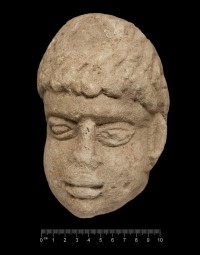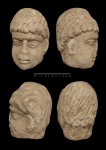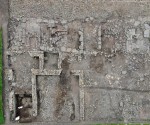 Durham University archaeologists excavating an ancient garbage dump on the site of a Roman bathhouse outside Binchester Roman Fort near the town of Bishop Auckland, County Durham, northeast England, have discovered a carved stone head dating to the 2nd or 3rd century A.D. Extremely lucky 19-year-old archaeology student Alex Kirton found the small sandstone sculpture — it’s about eight inches high and four inches wide — in a layer of stone rubble.
Durham University archaeologists excavating an ancient garbage dump on the site of a Roman bathhouse outside Binchester Roman Fort near the town of Bishop Auckland, County Durham, northeast England, have discovered a carved stone head dating to the 2nd or 3rd century A.D. Extremely lucky 19-year-old archaeology student Alex Kirton found the small sandstone sculpture — it’s about eight inches high and four inches wide — in a layer of stone rubble.
The bathhouse had fallen out of use by the 4th century and the locals used its rooms as dumpsters. These rooms are filled with trash six feet deep, mostly in alternating layers of stone materials and butchery discards. Two years ago a small Roman altar was found nearby along with a partial inscription that appears to commemorate a shrine dedicated by the commander of the fort cavalry. Archaeologists believe the head and altar were part of this modest shrine built inside the bathhouse.
 It’s not possible at this juncture to identify precisely who the head is meant to represent. The going hypothesis is that he was a local Romano-British deity. Binchester was a fort on the northern frontier and there were a number of gods unique to the area. One likely candidate is the god Antenociticus because the sandstone head shares some features in common with a confirmed head of Antenociticus discovered in 1862 in the Roman settlement outside Benwell, another northern border fort near Newcastle upon Tyne. The Benwell head was found in its original context, a temple dedicated to Antenociticus built around 180 A.D. Inscriptions indicate the temple was built by a Roman cavalry prefect to give thanks for a promotion, so Antenociticus appears to have had some kind of military purview.
It’s not possible at this juncture to identify precisely who the head is meant to represent. The going hypothesis is that he was a local Romano-British deity. Binchester was a fort on the northern frontier and there were a number of gods unique to the area. One likely candidate is the god Antenociticus because the sandstone head shares some features in common with a confirmed head of Antenociticus discovered in 1862 in the Roman settlement outside Benwell, another northern border fort near Newcastle upon Tyne. The Benwell head was found in its original context, a temple dedicated to Antenociticus built around 180 A.D. Inscriptions indicate the temple was built by a Roman cavalry prefect to give thanks for a promotion, so Antenociticus appears to have had some kind of military purview.
There are marked differences between the two heads, though. The Binchester head has a flat base; it’s likely that the head was the entirety of the sculpture. Neck fragments from the Benwell Antenociticus indicate it was part of a larger, life-sized sculpture. Pieces of a forearm and leg were also found at the site. The Benwell head is also more delicately carved, as you might expect from an artifact decorating a full-on temple rather than a small household shrine.
 The Binchester head also has facial features — mainly the modeling of the nose and lips — that may suggest an African influence.
The Binchester head also has facial features — mainly the modeling of the nose and lips — that may suggest an African influence.
The Binchester head is African in appearance, but Dr Petts, who is also Associate Director of Durham University’s Institute of Medieval and Early Modern Studies, said experts were unsure whether these features were deliberate or coincidental.
He explained: “This is something we need to consider deeply. If it is an image of an African, it could be extremely important, although this identification is not certain.”
Dr Mason added: “The African style comparison may be misleading as the form is typical of that produced by local craftsmen in the frontier region.”
The features are also damaged and archaeologists can’t be certain exactly how they looked when new.
 Binchester Roman Fort, called Vinovia by the Romans, was the largest fort in the county, housing a garrison of one thousand men, most if not all of them cavalry. It guarded the crossing point of the River Wear, a strategically important location about 60 miles north of the legion’s headquarters at York and about 30 miles south of Hadrian’s Wall. If you have the opportunity, head on up there the weekend of July 13th and 14th to see an exhibit of the newly discovered head as well as other artifacts discovered on site. There will be tours led by Dr. David Mason, Principal Archaeologist with the Durham County Council, and reenactments by Roma Antiqua and Legio IX including a working full-size model of a ballista, the torsion-powered catapult Romans used to fire artillery bolts at the enemy.
Binchester Roman Fort, called Vinovia by the Romans, was the largest fort in the county, housing a garrison of one thousand men, most if not all of them cavalry. It guarded the crossing point of the River Wear, a strategically important location about 60 miles north of the legion’s headquarters at York and about 30 miles south of Hadrian’s Wall. If you have the opportunity, head on up there the weekend of July 13th and 14th to see an exhibit of the newly discovered head as well as other artifacts discovered on site. There will be tours led by Dr. David Mason, Principal Archaeologist with the Durham County Council, and reenactments by Roma Antiqua and Legio IX including a working full-size model of a ballista, the torsion-powered catapult Romans used to fire artillery bolts at the enemy.